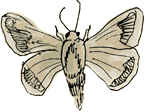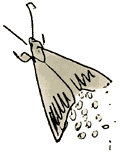European Corn Borer

The European corn borer's favorite food is corn, but it can attack the leaves, fruit, and stems of over 260 other plants, so you should look for and eliminate it as soon as you find it. It will eat into the corn, which will appear chewed and shriveled when you peel an ear.

- The caterpillar is about 1" (2.54 cm) long, grayish-pink with a dark head and spots.

- They pupate into a yellow-brown moth with 0.5" (13 mm) wings with dark bands.

- The adult moths will then lay white eggs on the undersides of leaves.

- The eggs hatch into plump, reddish-brown larvae which survive over the winter in the dead stalks of corn.
- As soon as your corn has been picked, cut down or pull up the stalks.
- Shred or chop up the leaves and stalks and compost them.
- This will eliminate any eggs and larvae that would hatch next year in your garden.
Fascinating Facts!
- The European corn borer is a type of moth that can be found in many parts of the world.
- The larvae of the European corn borer are known for causing damage to corn and other plants, by burrowing into the stems and leaves.
- European corn borers can cause significant economic losses in the agricultural industry.
- The adult European corn borer has a wingspan of about 1 inch (2.5 cm).
- The larvae of the European corn borer can grow up to 1 inch (2.5 cm) long.
- Female European corn borers can lay up to 400 eggs in their lifetime.
- Scientists have developed ways to control European corn borer populations, such as using pheromone traps and genetically modified crops.
bugs
caring
|





